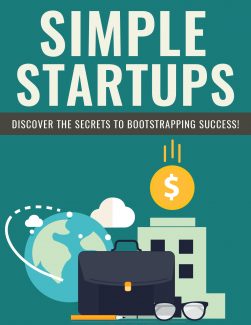 License Type: Private Label Rights
License Type: Private Label Rights  File Type: ZIP
File Type: ZIP
 SKU: 61952
SKU: 61952  Shipping: Online Download
Shipping: Online Download
Sample Content Preview
Introduction
Starting a business can be costly, especially in certain fields such as brick-and-mortar and retail. But there are ways to drastically reduce your startup costs, and to secure funding without giving away the rights to your company, or going into serious debt.
I can’t tell you how many times I’ve heard entrepreneurs lamenting over the fact that they gave a huge percentage of their company equity away to get angel investors or venture capital, and realized later they could have done it on their own without giving up so much equity. Let’s say you secure $100,000 from an angel investor in exchange for a 25% stake in your company. (Realistically, most investors ask for higher amounts, but we’ll use 25% for easier math.)
Now let’s say your company makes $1,000,000 in profit in its first year. This means your angel investor would receive $250,000 for that initial $100,000 investment, and that’s just in the first year! Over the years, this could add up to millions of dollars!
This is why it’s important to avoid seeking investors whenever possible, or to delay seeking funding as long as possible. (We’ll talk about the reasons for that later.)
In this guide, we’re going to talk about some of the best ways to save money, get profitable faster, and avoid having to seek funding before your company is truly ready. You’re going to learn how to start your business with the least possible investment, and how to manage your money until your company becomes profitable.
So, let’s get started.
Setting a Budget
According to a 2009 survey by the Ewing Marion Kauffman Foundation, the average startup cost for a business was around $30,000. It might be a bit higher now, given inflation, but you can expect the average is still somewhere in that ballpark.
Of course, startup costs can vary dramatically depending on the type of business you’re trying to start.
Opening a retail business or a restaurant, for example, might cost a minimum of $50,000 or more, because you have to pay for the physical space, fixtures, product, licensing, employee salaries, and more. But starting an online business focusing on digital products, affiliate marketing, drop shipping, or something similar might require as little as $25 to start. This is one big reason so many people start these types of businesses. There’s a lower barrier to entry.
Even $25 can be a significant investment for some people. If you’re already living on next to nothing, even such a small amount can seem like a fortune, especially when it comes to risking it with a potential for failure.
But entrepreneurs know that there’s no reward without risk, and only you know how much risk you’re willing to take.
So, the first thing you need to do (after you make the major decisions regarding the type of business you want to create and such) is figure out exactly how much you’re prepared to spend starting your business. A lot of this will probably depend on how much you have to spend. If you don’t have very deep pockets, and most of us don’t, you will be limited in the amount of money you have available to start your business.
Some people don’t mind risk, and they’re willing to put more of their available funds into their business in order to try to extract profit more quickly. Others prefer to risk a bit less and grow more slowly. Either way is fine. It’s up to you to decide how much risk you’re willing to take. This is why it’s important to set a budget and stick to it as much as you possibly can. If you have $20,000 in your savings account and you’re willing to risk half, then you need to set a budget that falls within the $10,000 you have available.
If you have no money available, and you’re starting with nothing, budgeting becomes even more important. You’ll have to find money somehow, and that’s not easy if you have no experience to prove your ability.
Determine exactly how much money you have to invest, and how much you’re willing to risk. Then sit down and total up every single expense you can possibly think of with regards to opening your business.
Don’t forget things such as:
• Product (either buying or developing it)
• Location (either a physical location or a website)
• Marketing expenses
• Employees or outsourcing expenses
• Office supplies and utilities
• Six to twelve months of operating capital
Take note of that last one. Many businesses don’t become profitable for at least the first 6-12 months, so it’s important not only to ensure you have enough capital to start your business initially, but also to run it until it becomes profitable.
Determine how much you are likely to need to run your business until it becomes profitable, and try to pad that number as much as you can in order to account for unexpected expenses.
Once you’ve determined your budget, you can start purchasing the things you need to open your business.
Sticking to Your Budget
Let’s talk about a few things you can do to make sure you stick to your budget once you have developed it. After all, a budget won’t make a difference if you don’t stick to it!
Using Credit
There may be times when using credit is absolutely necessary, but try not to use it unless you have to. Interest rates vary based on the type of loan/credit and your credit history, and can be as much as 30% or even higher for some types of high-risk loans. This kind of expense can destroy a brand-new company if it’s not managed carefully, so it’s wise to avoid using credit if at all possible.
The only thing you should use credit for is to obtain inventory, because it’s something you can sell for a profit, and then only if necessary. For example, if you find a good price on inventory that is a limited time offer, or if you run out of stock of your best-selling item and you need to get it back in stock urgently and you are waiting for payments to come in, then you can float with credit.
If you do this, be sure to pay back the entirety of the loan as quickly as possible, ideally within 30 days in order to avoid interest. Most credit cards will not charge interest until they generate a statement, so if you can pay off the balance before your statement is generated, you probably won’t have to pay interest.
This isn’t true for loans, however, so be sure to check the terms of any loan to see just how much you’re going to have to pay back.
Remember, if you end up paying high interest on something, even product you intend to sell, you eat into your profits. This is especially notable if you’re in a field that operates on razor-thin profit margins, such as consumer electronics. Such interest payments could erase your profits completely.
You may also occasionally have emergency expenses that you must use credit to cover—such as an unexpectedly high utility bill or some other expense you couldn’t have anticipated. This is another valid reason to use credit, but try to avoid doing so if you can find any other option.
Don’t forget that you can often transfer balances from one card to another, so if you have a balance on a card and you know you can’t pay it off in time to avoid interest, you could transfer the balance to another card with a lower interest rate or to buy time to pay it off. Also, consider getting business credit instead of using your personal credit. Some types of business credit can be obtained without risking your own personal credit score or your personal income, instead being opened in the name of the company using the company’s Federal tax ID number instead of a social security number.
Be sure to ask if the creditor requires a personal guarantee, also called a PG. If so, it means you could be sued directly if you default, and it can be reported to your personal credit report.
Keep An Eye On Cash Flow
In the early stages of a startup, cash is king. Cash flow is something that can easily get away from you if you’re not careful.
Be sure you carefully document your business expenses, including noting the date, amount, items purchased, where they were purchased, and keep receipts.
Not only will this help you stick to your budget, but you will need this information for taxes, because you will pay a huge amount of money in taxes if you aren’t able to claim deductions for your expenses! Some expenses can’t be written off on your taxes, but save the receipts anyway. You never know when you may need them.
Tax laws can and do change sometimes, and not only that, you may need to prove expense figures if you later decide to sell your company.
If you have employees, be sure that anyone who has access to petty cash or to company funds knows they must clear purchases with you first. One of the biggest reasons companies go over budget is through employees spending money on items that aren’t in the budget.
It’s always difficult when you don’t want to micromanage employees. Just be sure to let them know that cash flow is tight, and that’s the reason they are being asked to clear purchases with you first. You don’t want them thinking you don’t trust them.








